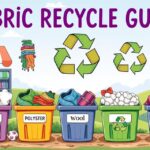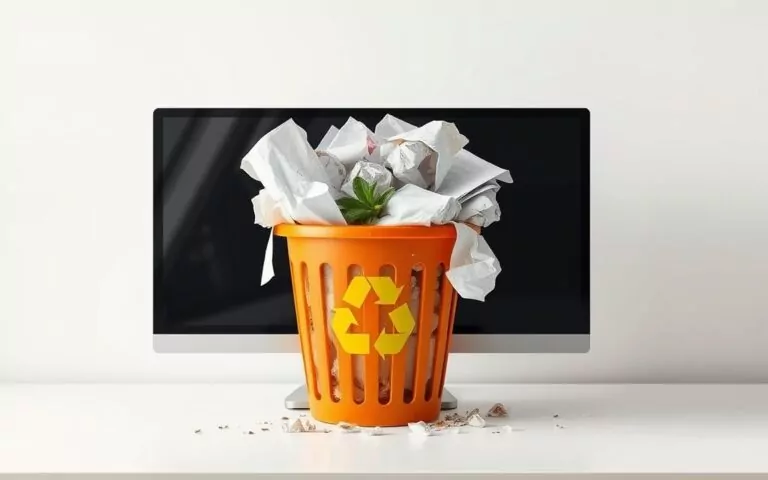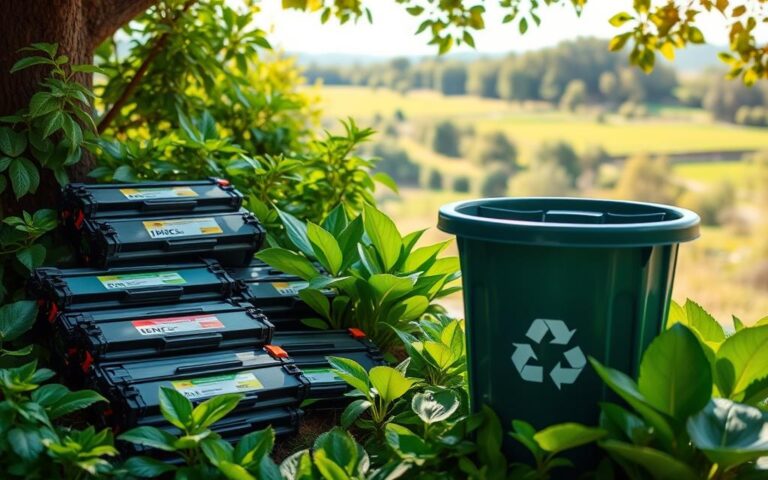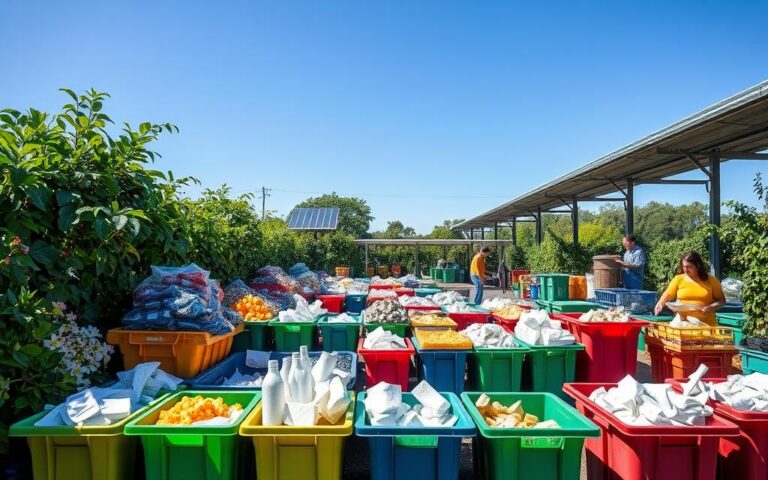How Do You Recycle Old Clothes? Sustainable Disposal Guide
In today’s world, fashion creates 10% of CO2 emissions each year. It’s key to find sustainable ways to get rid of clothes. Recycling old clothes helps cut down on waste and lessens environmental harm.
This guide will teach you how to dispose of clothes eco-friendly. We aim to help you make choices that are good for our planet.
Looking to donate, swap, or recycle old clothes? This guide explains your options. By adopting eco-friendly practices, you help our planet immensely. Join textile recycling efforts to combat unnecessary waste. You’ll support a circular economy and make a big difference.
The Importance of Recycling Old Clothes
We really need to recycle old clothes more than ever. Every year, we make a huge pile of textile waste. It’s vital to know the environmental impact of throwing away clothes. This helps us live in a more eco-friendly way. The fashion world, especially fast fashion, plays a big part in this problem. It makes us buy too much and throw away too much.
Environmental Impact of Textile Waste
Textile waste is a big problem for the Earth. About 85% of it ends up in landfills, which is about 17 billion pounds every year. In landfills, clothes can stay for up to 200 years. They release bad gases and poisons into the earth and water. Synthetic stuff like polyester is even worse because it takes so long to break down. The fashion industry also causes about 10% of the world’s CO2 emissions, mainly because of fast fashion.
Statistics on Clothing Disposal
The numbers on how we throw away clothes show we need to act fast. In New York alone, people throw out 200,000 tons of textiles each year. This takes up 5-6% of landfill space. Shockingly, less than 1% of the 200 billion clothes sold each year are recycled. We urgently need better recycling and buying habits.
| Statistic | Details |
|---|---|
| Annual Textile Waste | 17 billion pounds of clothing wasted |
| Recycling Rates | Approximately 15% of textile waste is recycled |
| Landfill Life Span | Clothes can take up to 200 years to decompose |
| Fast Fashion Impact | Fashion industry contributes to 10% of global CO2 emissions |
| New York Textile Waste | 200,000 tons discarded each year |
| Occupancy of Landfills | 5-6% of landfill space consumed by textile waste |
How Do You Recycle Old Clothes
Recycling old clothes starts by checking their condition. Understanding the state of your clothes helps decide how to disppose of them properly. By categorising them, you can minimise waste and avoid adding to landfills.
Understanding Different Clothing Conditions
First, look at each item you own. Clothes can mainly fall into three groups:
- Great Condition: These can be resold or given to charity. They are still nice to look at and fully usable.
- Good Condition: Suitable for thrift store donations. They may have slight wear but are good to wear.
- Poor Condition: These should not be thrown away but recycled. This ensures they’re processed properly.
Sorting Your Clothes for Effective Recycling
It is important to sort clothes right for recycling. Only about 25% of donated clothes get sold. Sending the rest to recycling helps the environment.
Here’s a table summarising how to sort effectively:
| Clothing Condition | Recommended Action | Potential Outcome |
|---|---|---|
| Great Condition | Donate or Resell | Helps those in need and supports the environment |
| Good Condition | Thrift Store Donation | Helps people find affordable clothes and reuses items |
| Poor Condition | Recycle | Cuts down on waste and allows materials to be reused |
Using these sorting methods will make your recycling more effective. It also makes practices more sustainable.
Options for Disposing of Gently Used Clothing
Giving away gently used clothes is a great way to help the planet and update your style. You can choose to sell, swap, or donate your clothes for a good cause. Each option keeps clothes out of trash sites and makes the most of what we already have.
Selling Your Old Clothes
Using sites like Poshmark and Depop to sell clothes is easy and lets you reach many buyers. You can sell clothes that are in fashion or classic items. This approach not only cuts down waste but can also give you some extra money. When you sell your old clothes, you’re doing your part for the environment.
Clothing Swaps and Community Exchanges
Setting up clothes swap events with friends is a fun way to be eco-friendly and build connections. These gatherings are a blast and inspire people to think green. Everyone gets to update their closet, share style tips, and find cool pieces without buying new ones. It’s a win-win for all and showcases the power of sharing.
Charity Donations Beyond Goodwill
Donating is a brilliant way to clear out your wardrobe. Charities like Soles4Souls and Dress for Success help those in need with specific clothing items. These charity donations not only bring comfort to the recipients but also promote sustainability. By exploring beyond common donation spots, your help can have a bigger effect.
Steps for Dealing with Unwearable Clothing
When your clothes can’t be worn anymore, it’s a chance to be creative. It’s important to look into fixing or transforming them. This guide covers how to breathe new life into ruined clothes and fun ways to use them.
Repairing Damaged Garments
Try to fix clothes to make them last longer and avoid waste. Simple sewing can fix minor rips, and patches can hide big tears in style. DIY projects like these can be fun and teach you useful skills. For hard fixes, getting help from a tailor might be best. Making an effort to repair clothes shows you care about the environment.
Creative Repurposing Ideas
Turning old clothes into new things is a clever way to reuse. Here are some fun ideas:
- Make tote bags from old t-shirts by cutting and tying the fabric.
- Turn jeans into cool pencil cases or planters.
- Create quilts from different fabrics for a special touch at home.
- Use worn-out fabric to make toys for pets.
- Make art with leftover pieces of fabric.
Using old clothes in these ways keeps them out of the trash and sparks creativity. It helps the planet and makes us see our clothes’ hidden value.
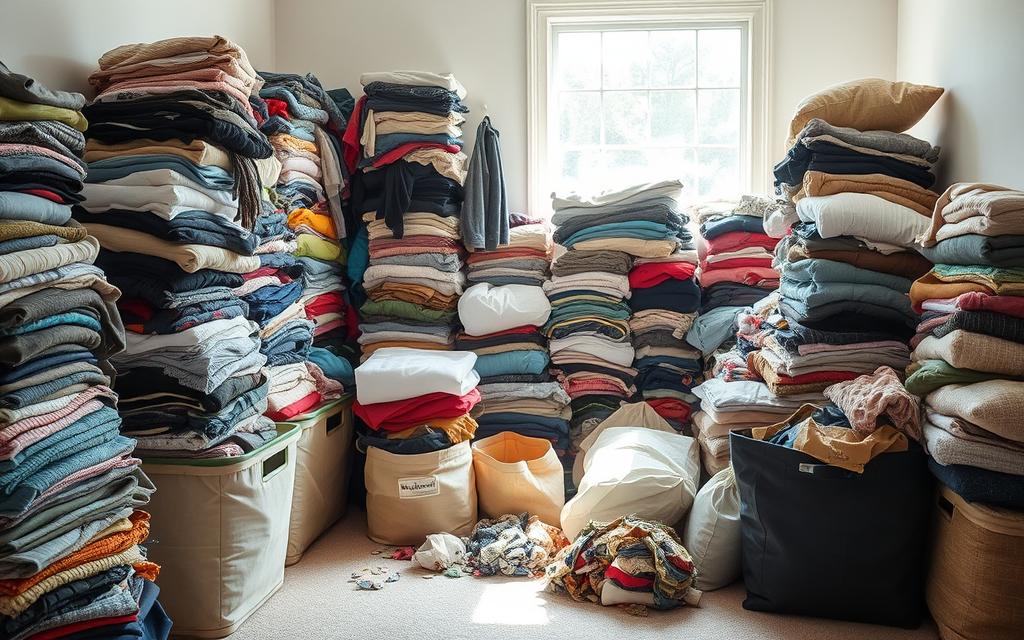
Recycling Initiatives and Programs
Many programs focus on reducing textile waste to aid sustainability. Retailers and community groups are key in textile recycling. They help people recycle clothes responsibly.
Knowing your recycling options is important. This knowledge supports better recycling practices.
Retailer Recycling Options
Several retailers offer programs for recycling old clothes. For example, H&M has been collecting any brand of clothing since 2013. They have collected over 172,700 tonnes of textiles, reselling 68% and recycling others. Patagonia takes back only its own textiles, showing a unique approach.
Nike’s reuse-a-shoe program recycles their shoes. Value Village, Goodwill, and Salvation Army sort and recycle waste. These efforts show the vital role of retail recycling in sustainability.
Local Recycling Facilities and Opportunities
Local centers are key for community recycling. Diabetes Canada’s blue boxes take all textiles, if dry. Websites like Earth911 help find local recycling spots.
Projects like Looper Textile Co. encourage reusing and recycling clothes. By using local facilities, you help the textile industry become more sustainable.
| Retailer | Recycling Initiative | Details |
|---|---|---|
| H&M | Garment Collecting Programme | Accepts any clothing item; over 172,700 tonnes collected since 2013. |
| Patagonia | Brand-Specific Recycling | Only accepts Patagonia textiles, emphasising sustainability. |
| Nike | Reuse-a-Shoe | Collects and recycles any Nike brand shoes. |
| Value Village | Sorting Waste | Sorts waste into appropriate streams for recycling. |
| Diabetes Canada | Textile Recycling Boxes | Accepts all dry or bagged textile items. |
| Goodwill | Recycling Programmes | Active sorting of textiles into sustainable streams. |
Innovative Ways to Extend the Life of Your Clothes
We need to make our clothes last longer to support sustainable fashion. By taking good care of them and joining in swap events, we can stop so much waste. This helps the planet.
Best Practices for Care and Maintenance
To look after your clothes better, follow these tips:
- Wash them less to keep them in good shape.
- Use gentle cycles and cold water for washing.
- Air drying is better than tumble drying.
- Fix any small tears or damage quickly.
- Opt for high-quality materials that last.
By doing these things, your clothes will last longer and you’ll be acting more sustainably. For extra tips on caring for your clothes, check out this detailed guide on textile recycling.
How to Participate in Clothing Swap Events
Joining clothing swap events is a great way to be sustainable. You can swap clothes with others, getting new things for your wardrobe. This is how it helps:
- It boosts community ties and promotes green habits.
- This reduces the need for new clothes, which is better for the environment.
- It’s a cost-free way to refresh your look.
By either starting or going to a clothing swap, you’re not just making your clothes last longer. You’re also part of a fun, community effort for sustainability. This approach to refreshing your wardrobe is becoming more popular.
Resources for Sustainable Clothing Disposal
Getting rid of old clothes can help cut down on textile waste. There are many ways to dispose of clothes sustainably. This helps both the environment and local communities. You can donate to local charities or use online selling platforms. This prevents clothes from piling up in landfills.
Finding Local Charities and Recycling Centres
Local charities are key to disposing of clothes sustainably. They accept gently used items. This aids those in need and minimizes waste. Among the notable charities are:
- Soles4Souls takes gently used shoes and provides free shipping.
- Donation Town helps you find local charities for clothing donations. They often offer pick-up from your home.
- USAgain plants a tree for every filled TreeMachine in certain areas. This helps make communities greener.
- Dress for Success gives work attire but often gets unusable items from drives.
Online Platforms for Selling or Donating Clothes
Many online platforms allow you to sell or donate clothes. They attract people interested in keeping fashion sustainable. These sites help clear out wardrobes and reduce landfill waste. Some key platforms are:
- ThredUp makes selling second-hand clothes easy and promotes green actions.
- Vinted lets users buy and sell clothes directly, giving items a second life.
- For Days offers a recycling bag for old clothes and credits for new buys. This encourages sustainable choices.
- Patagonia’s Worn Wear programme lets you return items for repair or resale. It supports a circular economy.
Conclusion
The importance of recycling old clothes is very big. The textile industry causes about 10% of the world’s carbon emissions. So, using sustainable ways to get rid of old clothes is key to lessening our environmental impact. Every piece of clothing can be part of the problem, with tons thrown away each year. If we choose to dispose of clothes responsibly, we can cut down our carbon footprint and save resources.
We have looked at different ways to handle old clothing in this article. We talked about donating to charities like Goodwill and going to clothing swaps. These actions help keep clothes in use longer and encourage a sustainable lifestyle in our communities. Since a lot of fast fashion gets thrown out within a year, it’s clear that our choices can make a big difference.
In the end, understanding how crucial it is to recycle clothes and taking action can lead to a group effort against textile waste. Every little step matters. By changing the way we deal with our clothes, we help create a better world for the next generation.
FAQ
Why is recycling old clothes important?
Recycling old clothes helps cut down the fashion industry’s environmental harm. This industry is linked to about 10% of the world’s CO2 emissions. By recycling, we keep over 85% of old clothes out of dumps. This reduces bad emissions and saves resources.
How can I determine the condition of my clothing for recycling?
Look at your clothes and put them into three groups. The first is great condition, perfect for reselling or giving away. The second is good condition, which thrift shops would love. Lastly, poor condition items are best recycled. Sorting them right is key.
What are my options for donating gently used clothing?
You’ve got lots of choices for donating clothes. Give shoes to Soles4Souls, men’s workwear to Career Gear, and women’s outfits to Dress for Success. Or, have a clothing swap with pals. It’s fun and eco-friendly.
What should I do with clothing that is beyond repair?
For clothes you can’t wear, get creative. Make old t-shirts into bags or quilts. Alternatively, take them to textile recycling places. This helps keep them out of rubbish dumps.
Are there retailers that offer recycling programs for old clothes?
Yes, shops like Patagonia and H&M encourage recycling old clothes. They sometimes offer discounts when you bring in old items. It’s a step towards eco-friendly fashion.
How can I extend the life of my garments?
To make your clothes last longer, wash them less and use gentle cycles. Always air dry them. These tips lessen damage and are better for the planet.
What resources are available for sustainable clothing disposal?
Look for local places that take clothing donations. Websites like ThredUp and Vinted let you sell or donate clothes. These options help you dispose of clothes in an eco-conscious way.









